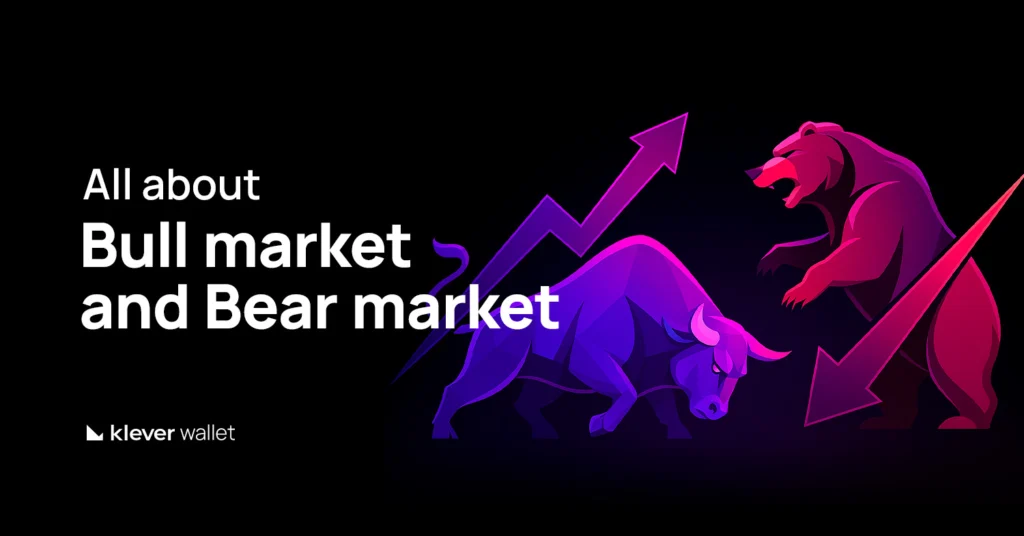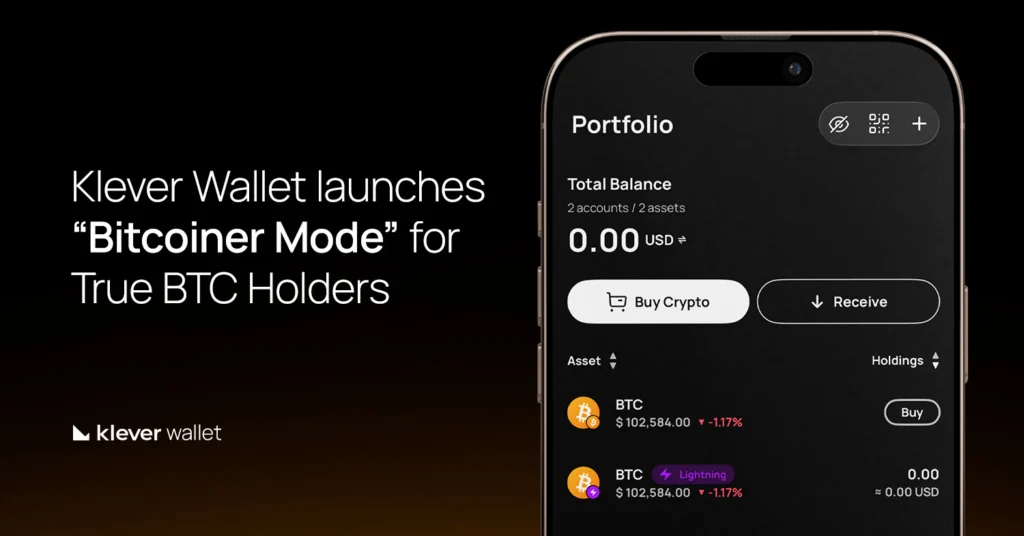
The crypto market has been on fire in recent days!
Bitcoin stole the spotlight by hitting its all-time high and, for a brief moment, surpassing Google’s market value.
But BTC wasn’t the only star — Ethereum surged to its highest level since 2022.
On top of that, the overall crypto market value exceeded $4.1 trillion, while new regulations — from the SEC to Google Play’s policy updates for digital wallets — reshaped the landscape.
Major events also left their mark, including a landmark legal milestone with the conclusion of the SEC vs. Ripple case.
It was a week of record-breaking milestones, regulatory developments, and strategic shifts — a clear reminder of why the crypto sector remains in the global spotlight.
Bitcoin Hits New All-Time High on August 13, 2025
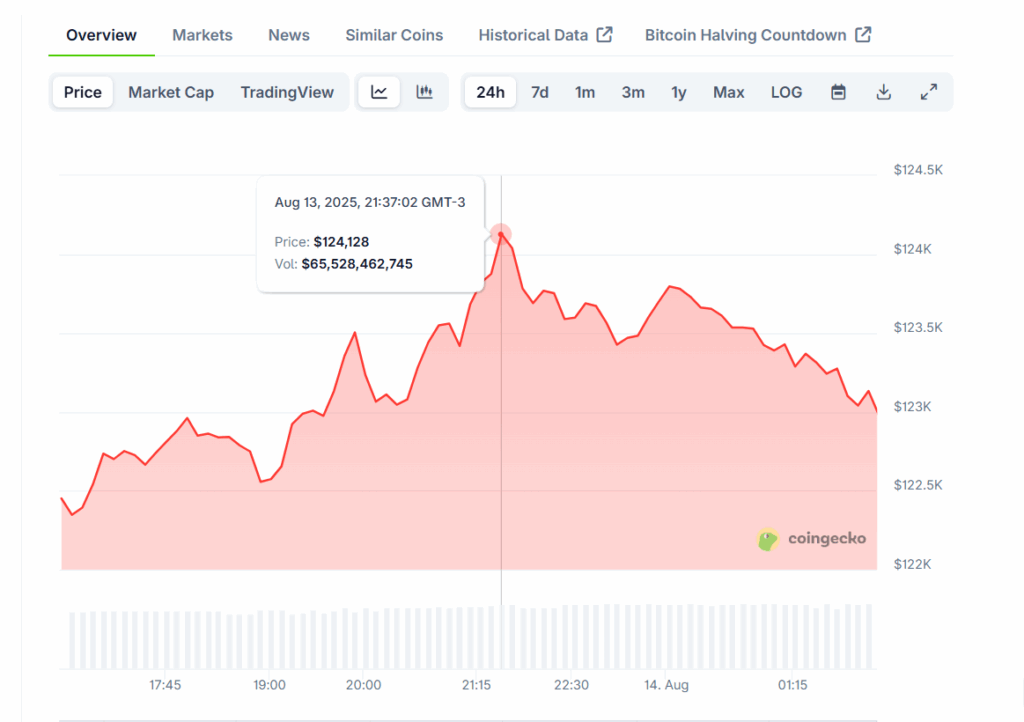
Source: Coingecko
Bitcoin (BTC) reached a new all-time high on August 13, 2025, surpassing the $124,000 mark.
This milestone was driven by a combination of macroeconomic factors, institutional inflows, and positive technical signals.
What Fueled the Record High
1. Anticipation of a Federal Reserve Rate Cut
- Expectations of up to a 50-basis-point interest rate cut by the Federal Reserve (Fed), projected for September, boosted demand for risk assets.
- Controlled inflation data reinforced these expectations.
- Statements from U.S. officials signaled a more growth-oriented economic stance.
2. Strong Capital Inflows into Bitcoin ETFs
- August 13 saw $86.91 million in net inflows into Bitcoin ETFs, raising the total assets under management for these products to $156.69 billion.
- BlackRock’s iShares Bitcoin Trust stood out among the offerings.
- Asset managers and corporations maintained steady, structured purchases.
3. Pro-Crypto Policies in the U.S.
The Trump administration bolstered the sector with measures such as:
- Allowing cryptocurrencies to be included in 401(k) retirement plans.
- Providing a clearer, more business-friendly regulatory environment for crypto companies.
4. Correlation with the Stock Market
Both the S&P 500 and Nasdaq hit new all-time highs, reinforcing risk appetite and benefiting BTC.
5. On-Chain Indicators Showing Market Strength
Data from Glassnode revealed that Bitcoin’s realized price surpassed the 200-week moving average (200-WMA) — a technical signal historically linked to extended bull cycles.
Bitcoin Surpasses Google’s Market Cap as Price Hits $124,457

Source: CoinGecko
Bitcoin (BTC) reached a new all-time high of $124,457, briefly overtaking Alphabet (Google) in market capitalization at around $2.45 trillion. This milestone positioned Bitcoin as the fifth-largest asset in the world, surpassing tech giant Google for the first time.
Investor Reactions and Market Sentiment
The crypto community celebrated the achievement:
- Tyler Winklevoss, Gemini co-founder, remarked on X: “Bitcoin all-time high and it’s only Wednesday.”
- Investor Kyle Chassé suggested it could be the “best week for Bitcoin” yet.
Institutional Adoption and Macro Drivers
The surge in Bitcoin’s value is being fueled by:
- Institutional Inflows – Record investments into spot Bitcoin ETFs.
- Regulatory Progress – Clearer rules and policy shifts enabling crypto in retirement accounts like 401(k) plans.
- Macroeconomic Tailwinds – Anticipation of Fed rate cuts and global economic easing.
Bitcoin’s rally helped push the total cryptocurrency market capitalization past $4.1 trillion for the first time in history, signaling unprecedented global adoption of digital assets.
Bitcoin Price Falls Below $119K as U.S. Treasury Rules Out New BTC Purchases
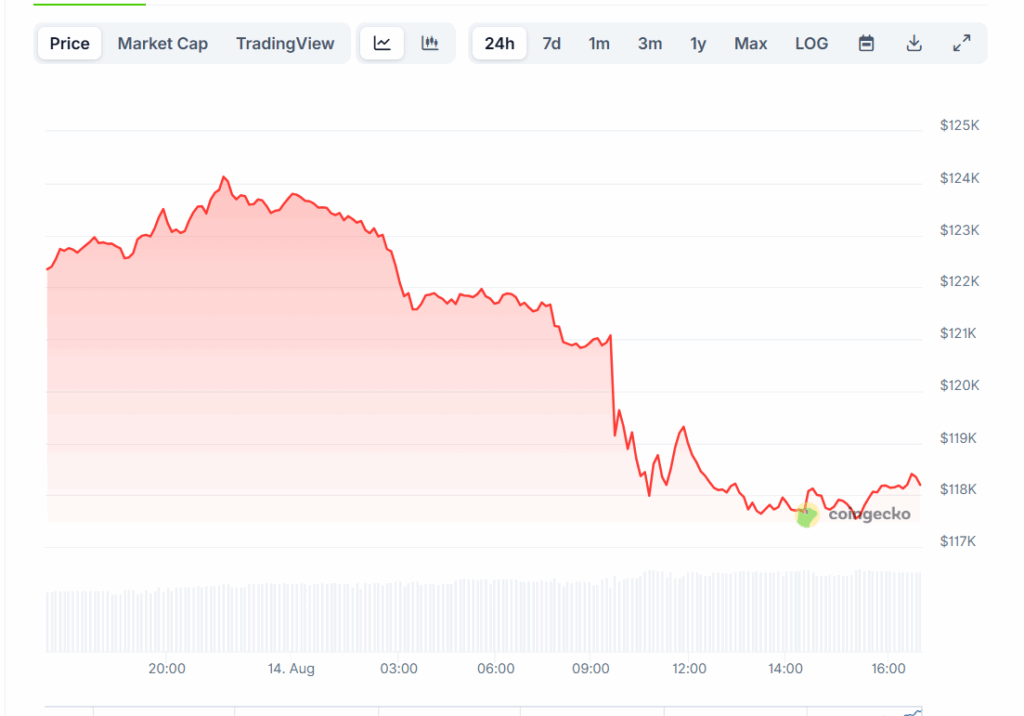
Source: Coingrecko
Bitcoin (BTC) slid to around $118,730 on Thursday, falling below the $120,000 psychological support level just hours after hitting a record high of $124,457.
The drop followed a statement from U.S. Treasury Secretary Scott Bessent, who confirmed that the government will not purchase additional Bitcoin for its strategic reserve.
Treasury’s Stance on the Strategic Bitcoin Reserve
Bessent told Fox Business that the U.S. will continue building its strategic Bitcoin reserve exclusively through confiscated crypto assets, with no taxpayer-funded acquisitions.
The Treasury also plans to stop selling its existing crypto holdings, currently valued between $15–$20 billion.
Background: The reserve was created on March 6, 2025, under a Trump executive order to store Bitcoin and other digital assets seized in criminal or civil cases.
Market Impact and Investor Sentiment
The announcement triggered a swift BTC price correction, wiping out part of the gains from its intraday rally.
Many in the crypto industry had anticipated active government Bitcoin purchases—a factor that fueled bullish sentiment—but this expectation has now been ruled out.
What This Means for the Crypto Market
- No Government Buying Pressure – Institutional investors and ETFs may now become the primary market movers.
- Reserve Growth Still Ongoing – Accumulation will rely solely on confiscated assets, keeping reserve growth “budget neutral.”
- Investor Focus Shift – Attention may pivot to ETF inflows, macroeconomic data, and global adoption rather than government accumulation.
Ethereum Rises 6%, Surpasses $4,500 for the First Time Since 2021
On August 12, 2025, Ethereum (ETH) gained 6.2% in a single day, breaking above $4,500 for the first time since November 2021.
The weekly gain now stands at 26%, while the monthly surge has already exceeded 50%, bringing the asset closer to its all-time high of $4,878.
Key Drivers Behind Ethereum’s Rally
1. Short Position Liquidations
- In just 24 hours, $104 million worth of Ethereum short positions were liquidated.
- ETH led crypto market liquidations, which totaled $154 million over the same period.
2. Record Inflows into Ethereum ETFs
- On August 11, Ethereum ETFs saw $1 billion in net inflows — surpassing Bitcoin ETFs for the first time.
- Companies like Bitmine Immersion Technologies plan to increase their corporate ETH holdings, currently estimated at $5 billion, to as much as $20 billion.
3. Supportive Macroeconomic Environment
- U.S. inflation data (CPI) boosted expectations for a Federal Reserve rate cut, benefiting risk assets such as ETH.
Ethereum Nearing Its 2021 Peak
Ethereum (ETH) reached $4,753, up 1.2% on the day, but still below its all-time high of $4.8K set in 2021.
According to Sean Dawson (Derive), ETH’s support comes from the growth of Digital Asset Treasuries (DATs), which accumulate staking rewards — a feature not offered by ETFs.
The SEC’s recent exemption of staking from securities laws has further strengthened this trend.
Cryptocurrency Market Hits $4.1 Trillion Record, Surpassing Microsoft and Apple
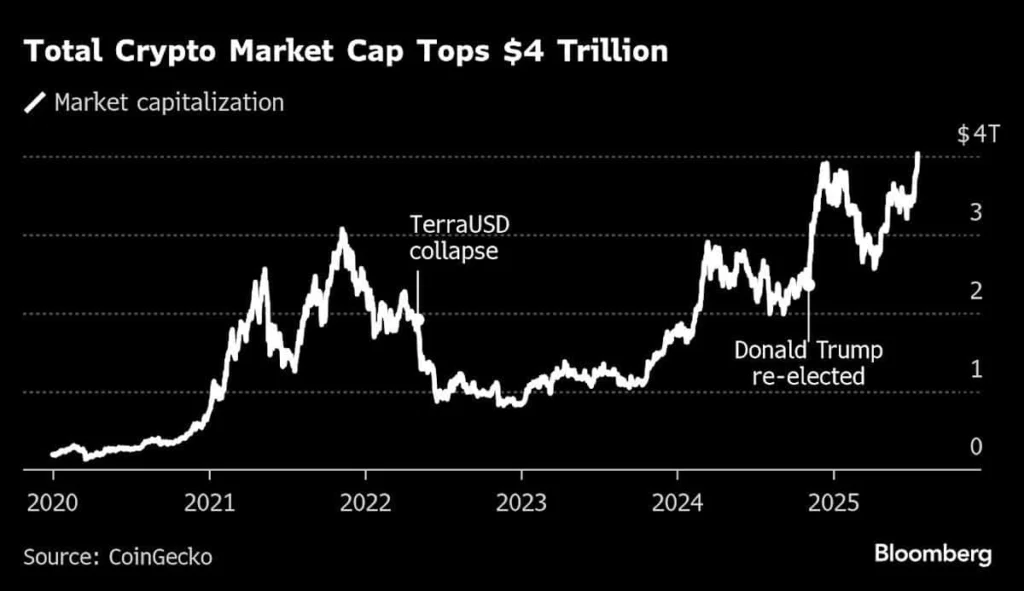
On August 11, 2025, the total cryptocurrency market capitalization reached an all-time high of $4.1 trillion, according to TradingView data.
This milestone placed the sector ahead of giants like Microsoft and Apple, making it the third-largest market in the world — behind only gold and Nvidia.
Bitcoin and Ethereum Lead the Surge
- Bitcoin (BTC): Trading near its all-time price high.
- Ethereum (ETH): Up 47% in the month, driven by strong institutional demand.
These two cryptocurrencies spearheaded the rally, alongside notable gains in several altcoins.
Key Factors Behind the Record
- Expected Federal Reserve Rate Cut: Growing anticipation of a U.S. interest rate reduction is making cryptocurrencies more attractive than fixed-income investments.
- New Pro-Crypto Guidelines in the U.S.:
- 401(k) retirement plans can now include cryptocurrencies.
- Banks are prohibited from denying services to crypto companies solely based on reputation.
- 401(k) retirement plans can now include cryptocurrencies.
- Capital Returning to Crypto Funds: Between August 4 and 8, the market saw $572 million in net inflows, reversing weeks of outflows.
Why This Milestone Matters
- Institutional Strength: Confirms massive capital inflows from corporations and investment funds.
- Market Consolidation: Positions crypto closer to the most valuable markets in the world.
- Global Credibility Boost: With more favorable policies, the outlook for crypto adoption continues to strengthen.
Google Play Updates Crypto Wallet Rules

Starting October 29, custodial cryptocurrency wallet apps on Google Play will need to comply with new licensing and compliance rules in more than 15 jurisdictions, including the United States and European Union.
- U.S. Requirements: Developers must be registered as a Money Services Business (MSB) with FinCEN or hold a state money transmitter license.
- EU Requirements: Developers must become Crypto-Asset Service Providers (CASPs) under the Markets in Crypto-Assets (MiCA) regulation.
- These changes will require stricter Anti-Money Laundering (AML) and Know Your Customer (KYC) processes for custodial wallet services.
Non-Custodial Wallets Exempt from New Rules
Google confirmed that non-custodial wallets—apps where users control their own private keys—are not affected by these licensing requirements.
The clarification came via an official Help Center update and a statement on X (formerly Twitter) after initial backlash from the crypto community.
Crypto Community Reactions and Developer Concerns
The announcement initially sparked fear that Google could target self-custody apps, which are vital to DeFi and user sovereignty.
While the exemption eased concerns, some developers still report issues—such as MannaBitcoin claiming delisting without warning and loss of five-star reviews—highlighting ongoing tensions between crypto apps and app store policies.
Why This Matters for Users and Developers
- For Custodial Wallet Developers – Higher compliance costs and barriers to entry could push smaller players out.
- For Non-Custodial Wallet Developers – Operations remain unchanged, but vigilance is necessary given platform control risks.
- For Users – Self-custody wallet access is secure, but custodial app availability may decrease.
SEC and Ripple End Legal Dispute: XRP Jumps Over 8%

The long-running legal battle between the U.S. Securities and Exchange Commission (SEC) and Ripple Labs officially came to an end on August 7.
After nearly five years of dispute over the classification of the XRP token as a security, both parties agreed to drop their appeals, with each side covering its own legal costs.
The news boosted XRP’s price, which surged more than 8.3% to $3.33, according to CoinGecko. The token continued climbing the next day, reaching $3.36.
Summary of the SEC vs. Ripple Case
- Case Initiation (Dec 2020): The SEC accused Ripple of conducting an unregistered securities offering through the sale of XRP.
- Partial Ruling (2023): Judge Analisa Torres ruled that institutional sales of XRP qualified as securities offerings, but sales on public exchanges did not fall under this classification.
- Conclusion (2025): The case was closed with Ripple agreeing to pay a $125 million fine while maintaining restrictions on institutional sales.
Immediate Impact on XRP Price
- XRP surged 8.3% within hours of the announcement.
- The rally pushed the token’s value to $3.33, marking one of its biggest gains in 2025.
- Investors viewed the case’s resolution as a sign of greater regulatory clarity and reduced legal risk for XRP.
What the Resolution Means for the Crypto Market
Legal Certainty
The decision sets an important precedent, clearly distinguishing between public exchange sales (not securities) and institutional sales (securities).
Adoption Potential
With legal uncertainty diminished, companies and institutional investors may reconsider XRP as part of their operations.
Industry Impact
Ripple’s partial victory could influence other SEC-related cases involving crypto companies, helping shape the future of U.S. sector regulations.
Circle Shares Jump 11% on Record Revenue and Arc Blockchain Announcement

On August 12, 2025, Circle (CRCL) shares surged 11.4% in pre-market trading, surpassing $179, following the release of record financial results and the announcement of its new first-layer blockchain, called Arc.
Financial Results Drive the Rally
- Total revenue and reserve income grew 53% year-over-year, reaching $658 million.
- The main growth driver was a 90% increase in USDC circulation, generating $634 million in yields.
- There is currently $65.6 billion worth of USDC in circulation worldwide.
Launch of the Arc Blockchain
- Arc will be an EVM-compatible Layer-1 blockchain.
- USDC will serve as the native gas token, directly integrating the stablecoin into the network’s operations.
- Public testing for Arc is expected to begin by the end of 2025, with integration into Circle’s products to follow shortly after.
Supportive Regulatory Environment
- The rally was also fueled by regulatory progress in the U.S.:
- The GENIUS Act established a clear framework for stablecoins, benefiting issuers like Circle.
- The GENIUS Act established a clear framework for stablecoins, benefiting issuers like Circle.
- This development strengthens institutional confidence in USDC and could accelerate its global adoption.
CrediX Recovers $4.5M in Crypto After Hack
DeFi platform CrediX has successfully negotiated the return of $4.5 million stolen in a recent exploit.
According to the project’s announcement, the attacker agreed to return the funds in exchange for an undisclosed settlement paid from the platform’s treasury.
CrediX confirmed it will reimburse victims within 48 hours via an airdrop of the recovered assets.
This rapid action aims to restore trust and stabilize community sentiment after the breach.
Industry Context: Recovery Deals on the Rise
The CrediX case reflects a growing DeFi trend where exploited projects negotiate settlements with attackers:
- GMX Exploit – $40M returned after a $5M bounty.
- Wallet Poisoning Scam 2024 – $71M returned under pressure from investigators.
However, data from Immunefi reveals that 80% of crypto assets never regain their value after a hack—showing the long-term challenges for recovery.
Details of the Exploit
Security reports show the hack was not a smart contract bug but abuse of centralized admin privileges:
- Attacker used multisig and bridge wallet control to mint unbacked tokens.
- Liquidity drained across connected pools.
- Around 50% of stolen funds routed through Tornado Cash for obfuscation.
The breach also hit Trevee, a protocol with exposure to CrediX through scUSD positions, causing liquidity shortages and temporary operational pauses.



